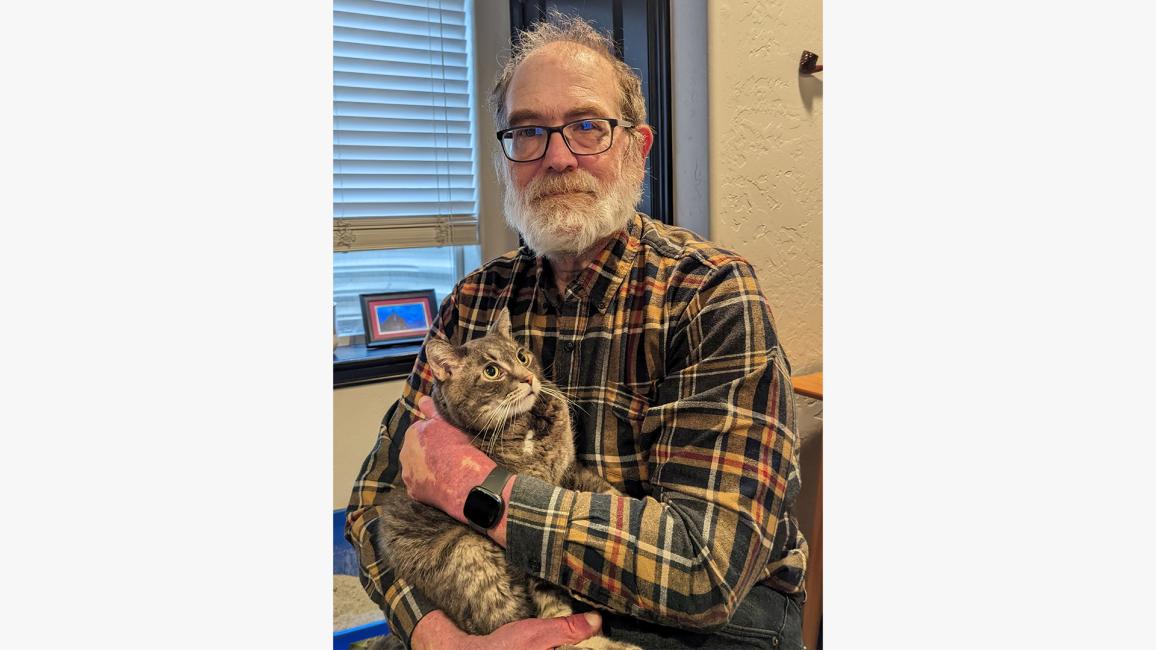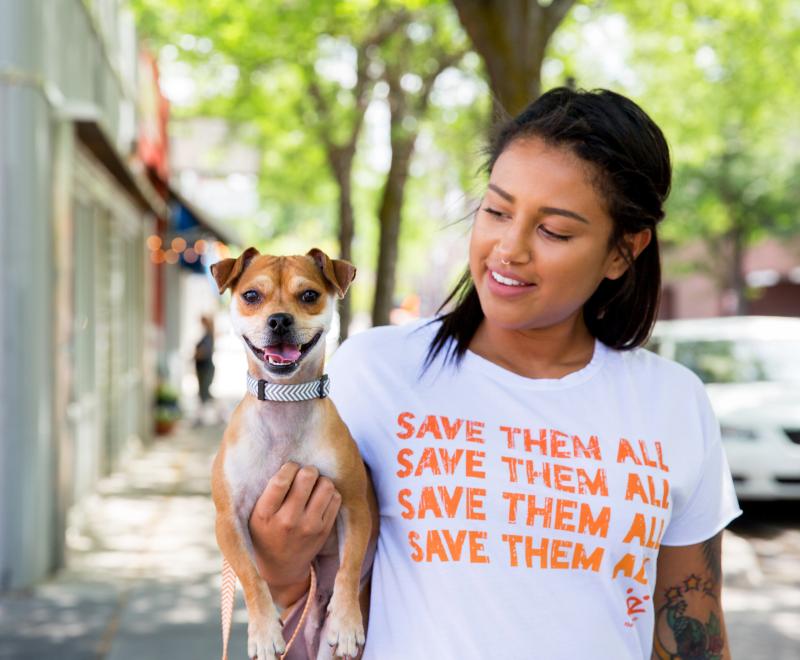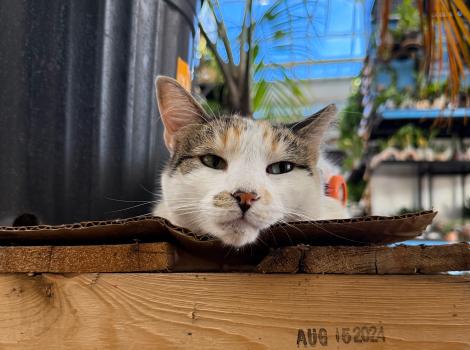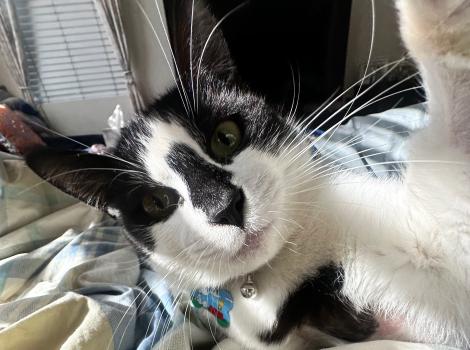Faces of No-Kill: Cat finds kindred spirit in foster care

Retired economist Kerk Phillips is embracing his new role as a foster volunteer.
“My job now is to make cats happy,” he says.
This story is a part of our Faces of No-Kill series, highlighting the journey of pets who lost their place to call home. These pets are thriving today thanks to animal shelters that said yes to lifesaving with a community that found a way to save them. Best Friends’ goal is for every shelter and every community to reach no-kill, and this story shows why that’s so important.
Kerk and his wife, Yeongmi, recently moved to Utah and have since cared for five foster felines from the Best Friends Lifesaving Center in Salt Lake City. The couple doesn’t shy away from tough cases, such as kitties with behavioral and medical challenges. One of their foster charges — a handsome gray tabby named Battleship — completely transformed during his time in their care. But Kerk will say he’s the one who was changed for the better.

The unsinkable Battleship
At the center, the 7-year-old cat was shy and anxious about being around so many unfamiliar animals. With time, Battleship, who has diabetes, started warming up to his caregivers, but he was still aloof — likely because he wasn’t feeling well. He also wobbled when he walked, the result of nerve damage in his feet caused by the diabetes.
Battleship’s diabetes was tricky to treat. The vet team kept adjusting his insulin dosage, but his glucose levels were still out of whack. To make matters worse, he wasn’t interested in eating, which was a big problem because his insulin had to be taken with food. And that wasn’t all.
[Senior diabetic cat finally gets her day in the sun]
“The stress he was experiencing also can cause his insulin levels to rise artificially, which made it even harder for our vet to determine what his appropriate insulin dose is,” says Finn Drew, lifesaving and care specialist with Best Friends.
Sometimes, the best treatment isn’t just about medicine. Yes, Battleship needed to receive regular insulin injections and a special diet. But he also needed a space to decompress — and he would get it in foster care.

Finding safe harbor
When Battleship first arrived at his foster home, relaxation was top priority. “We got him out of the carrier, and he walked around like he was wearing clown shoes,” says Kerk of Battleship’s wobbly walk from nerve damage.
Battleship claimed a storage cubby as his own, emerging twice a day to eat and receive his insulin shots. The rest of the time, he was asleep, enveloped in the darkness of his hideaway. Kerk recognized that despondent behavior because he also has diabetes.
“I know what this is like. If your blood sugar gets really high, you feel drowsy and don't feel like doing anything,” says Kerk.
Even though Kerk and Yeongmi hadn’t yet seen much of Battleship’s personality, they were still enamored with their foster boy (especially his big, innocent eyes). The couple started calling him by a special nickname, Mansei, which means “long live” in Korean. It’s because that’s what they wanted for Battleship: for him to live a long, happy life.
Fortunately, Battleship’s appetite returned. He was on a strict diet for diabetes, but Kerk still found ways to use food to bring Battleship out of his shell. Kerk gave Battleship a slow-feeder toy for enrichment and made trails of kibble to get him moving.
With each bite of kibble, their bond grew stronger.
“He’s got diabetes. I’ve got diabetes. He’s got neuropathy. I’ve got a little bit of neuropathy, so I walk funny, too,” says Kerk. “We had a lot in common.”

Turning a corner
After several weeks and multiple trips to the vet, the medical team finally found the right insulin routine for Battleship. “When they got (the insulin dosage) dialed in, he was like a different animal,” says Kerk. “He kind of got his mojo back.”
With his glucose levels in check, Battleship’s whole demeanor transformed. He started grooming himself, exploring the house, and playing with toys he’d previously ignored. His absolute favorites were fuzzy balls on a string. His mission? Hunt them down, snatch them up, and then see how many he could fit into his mouth. (His record was three balls, though he once made a heroic attempt at six.) Watching Battleship pounce and leap, you’d never know he was the same cat who could barely walk one month ago.
“Despite the fact that he had all that nerve damage in his hind end, he could jump pretty good,” says Kerk.
It wasn’t just toys that got Battleship’s motor going. Turns out, he loved attention and affection (head scratches, in particular). This sweet guy started greeting his caregivers with purrs and gentle nudges, always wanting to be by their side.

Fair winds and following seas
After four months in foster care, Battleship was healthy, strong, and ready for a home of his own. Kerk and Yeongmi would have adopted him in an instant. However, Battleship didn’t love the company of the couple’s other cats. Even though it would break their hearts to say goodbye, they knew he would thrive in a home where he could soak up all the attention.
Meanwhile, a woman named Dianne was looking to adopt an older kitty to keep her company. Coincidentally, she had experience caring for a cat with diabetes. So Best Friends staff arranged for Dianne to meet Battleship.
“They seemed to match energies and connect really well,” says Finn. After that first meeting, Dianne knew Battleship was the one for her.
With instructions from staff and insight from Kerk and Yeongmi, Dianne felt confident and equipped to care for her new best friend. They said goodbye to everyone who had grown to love Battleship so much and set a course for home.
[Diabetic senior cat finds his place in adopter’s lap]
“Everyone was so happy for him,” says Finn. “Being able to see him go from a scared, stressed cat with lots of medical issues to a laid-back, happy, and relaxed cat in foster care, then helping get him sent off to a home to live out his golden years really feels amazing!”
Kerk and Yeongmi will always have a place in their hearts for Battleship. But for now, they’re off to help the next feline in need. The couple says they wouldn’t hesitate to take in another cat with diabetes and would encourage others to consider it, too. These special pets do require a little extra care, but they say giving insulin shots isn’t as daunting as it seems. Besides that, they’re just like any other cat.
“They all want the same things. They all want food, water, and shelter, and they want socialization,” says Kerk. “It's just what form those take is different for every cat.”

Let's make every shelter and every community no-kill in 2025
Our goal at Best Friends is to support all animal shelters in the U.S. in reaching no-kill in 2025. No-kill means saving every dog and cat in a shelter who can be saved, accounting for community safety and good quality of life for pets.
Shelter staff can’t do it alone. Saving animals in shelters is everyone’s responsibility, and it takes support and participation from the community. No-kill is possible when we work together thoughtfully, honestly, and collaboratively.






